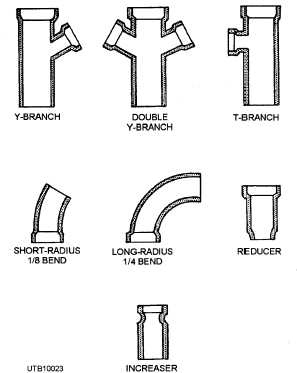After the pipe is taken from the casting, it is glazed and fired in large kilns to create a moistureproof baked finish. It is used for house sewer lines, sanitary sewer mains, and storm drains. The types of fittings for clay pipe are primarily bends, tees, and Y-branches.
You may have to use plain precast concrete pipe for sewers in the smaller sizes-less than 24 inches. This pipe is not reinforced with steel. This concrete pipe is similar to vitrified clay pipe in measuring, cutting, joining, and handling.
HANDLING AND STORAGE OF CLAY PIPE. - Be careful when you store and handle clay pipe because it is very fragile and cracks easily. Never drop clay pipe or roll it down an embankment without control. Do not drop heavy objects on clay pipe. When backfilling a trench, do not use fill with rocks or other heavy debris in it. Tamp by hand or by pneumatic tampers, bearing in mind the density of the backfill. Clay pipe should be laid in a trench and bedded evenly and firmly. The more perfect the bedding, the greater the load the pipe can sustain. Common sense can save a lot of time by eliminating rework.

Figure 3-24. - Gross section of clay or concrete fittings.
CUTTING. - Vitrified clay and concrete pipe, both available in such short lengths, seldom need cutting except for manholes and inlets. If, after measurement, you have to cut vitrified clay or concrete pipe, score it with a chisel, deepening the cut gradually until the pipe breaks cleanly at the desired point. Vitrified clay and concrete pipes may be cut with CISP “snap-off’ or “chain” cutters.
FITTINGS. - Figure 3-24 shows some common fittings used with vitrified clay and concrete pipes. Note that these types of pipes are used outside the building. This greatly reduces the number of different types of fittings required.
JOINING. - Joints on vitrified clay and concrete pipe may be made of cement or bituminous compounds. Cement joints may be made of grout, which is a mixture of cement, sand, and water. The following procedure may be used as a guide in joining pipe with grout. This procedure is very similar for joining pipe with bituminous compounds.
Insert the spigot of one length of pipe into the bell of the other and align the two pieces to the desired position.
Caulk a gasket of oakum about 3/4-inch thick into the bell to prevent the grout from running into the pipe.
Mix grout, using 1 part portland cement, 2 parts clean, sharp, washed sand, and sufficient water to dampen thoroughly.
Fill the joint with grout, using a packing iron.
Recaulk the joint after 30 minutes with a packing iron. You have to close shrinkage cracks that occur after the initial set of the grout.
Smooth and bevel the grout off with a trowel. In hot weather, cover the joint with a wet burlap sack.
Remove excess mortar with either a swab or a scraper.
Note that a regular swab, with some additional rags tied to the end to compensate for larger size pipe, is ideal for dragging through each length to remove the excess mortar.
The use of "speed seal joints" (rubber rings) in joining vitrified clay pipe has become widespread. Speed seal joints eliminate the use of oakum and mortar joints for sewer mains. This speed seal is made a part of the vitrified pipe joint when manufactured. It is made of permanent polyvinyl chloride and called a "plastisol joint connection." This type of joint helps to ensure tight joints that are rootproof, flexible, and so forth.
The speed seal, or mechanical seal, joint can be installed quickly and easily by one person. To make the joint, first insert the spigot end into the bell or hub.
Continue Reading